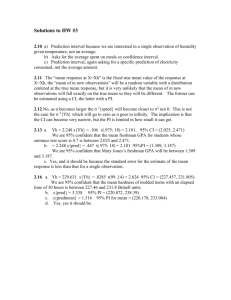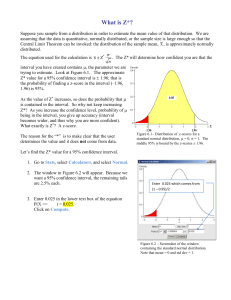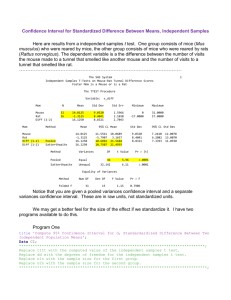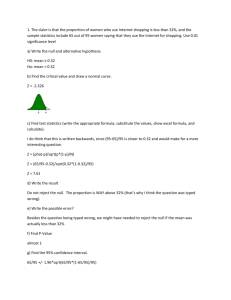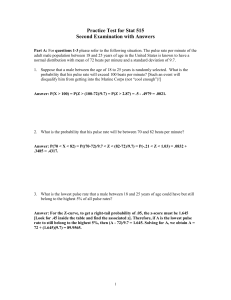HW Set One Addendum
advertisement
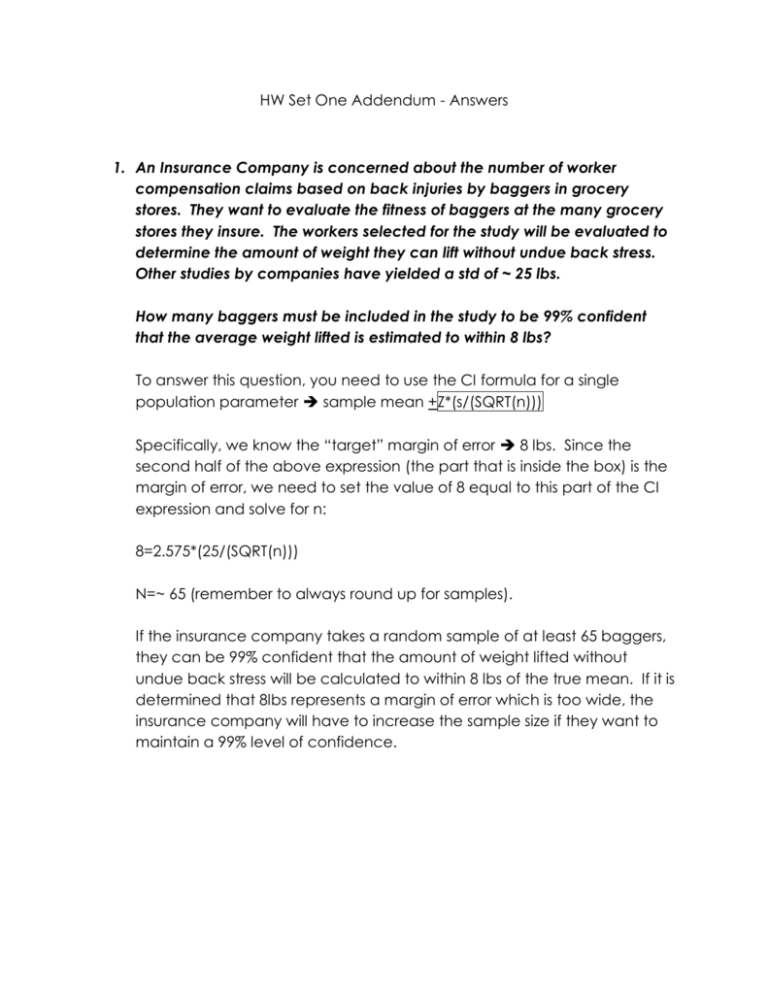
HW Set One Addendum - Answers 1. An Insurance Company is concerned about the number of worker compensation claims based on back injuries by baggers in grocery stores. They want to evaluate the fitness of baggers at the many grocery stores they insure. The workers selected for the study will be evaluated to determine the amount of weight they can lift without undue back stress. Other studies by companies have yielded a std of ~ 25 lbs. How many baggers must be included in the study to be 99% confident that the average weight lifted is estimated to within 8 lbs? To answer this question, you need to use the CI formula for a single population parameter sample mean +Z*(s/(SQRT(n))) Specifically, we know the “target” margin of error 8 lbs. Since the second half of the above expression (the part that is inside the box) is the margin of error, we need to set the value of 8 equal to this part of the CI expression and solve for n: 8=2.575*(25/(SQRT(n))) N=~ 65 (remember to always round up for samples). If the insurance company takes a random sample of at least 65 baggers, they can be 99% confident that the amount of weight lifted without undue back stress will be calculated to within 8 lbs of the true mean. If it is determined that 8lbs represents a margin of error which is too wide, the insurance company will have to increase the sample size if they want to maintain a 99% level of confidence. 2. The caffeine content in mg was examined for a random sample of 50 cups of black coffee dispensed by a new machine. The mean and std were 110 mg and 7.1 mg, respectively. Use this information to construct a 95% confidence interval for µ and explain. This is a simple application of the single sample parameter expression from above: sample mean +Z*(s/(SQRT(n))) Simply substitute the values into the expression: 110+1.96*(7.1/SQRT(50)) From the information provided from the samples, we are 95% confident that the caffeine content in the black coffee dispensed by the new machine is between 108.03mg and 111.97mg. 3. A courier company in NYC claims that its mean delivery time to any place in the city is less than 3 hours. A recent client was suspect of this claim. In response, the company randomly selected 50 deliveries and found the mean to be 2.8hrs with a std of .6 hrs. a. Estimate the mean delivery time using a 95% interval. b. Based upon the 95% interval, does the company’s claim appear to be reasonable? c. If a 99% interval was used to estimate the delivery average, would your answer to b. change? Why or Why not? This is yet another simple application of the single sample parameter expression from above: sample mean +Z*(s/(SQRT(n))) Simply substitute the values into the expression: 2.8+(1.96*(.6/SQRT(50))) From the information provided from the sample deliveries, we are 95% confident that the actual mean delivery time is between 2.6337 hours and 2.9663 hours (ooh, that’s close). Based upon the 95% interval, the company’s claim does appear to be reasonable – the full interval is less than their claim of 3 hours. At a 99% level of confidence, the new interval is between 2.5815 hours and 3.0185 hours. Since the 3 hour mark is included in this interval, the company’s claim might be challenged. To be specific, in slightly more than 1 out of every 200 deliveries, they would not be expected to meet the 3 hour delivery claim.


